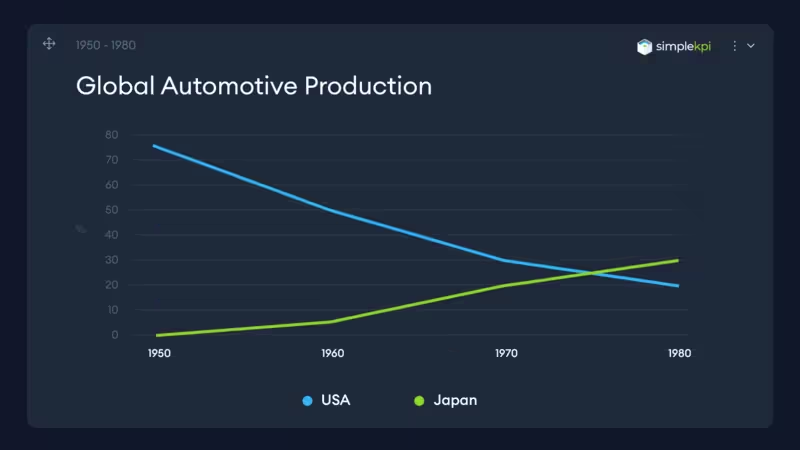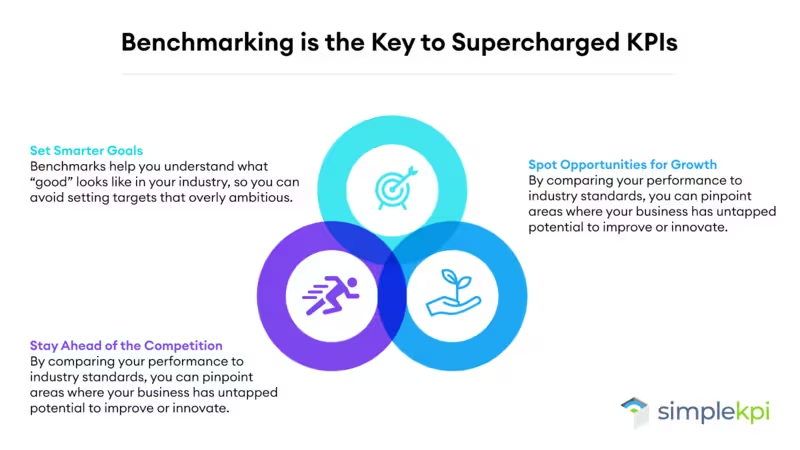In the 1950s, Japan was emerging from World War II, with a small manufacturing industry. Japanese automakers, such as Toyota and Honda, were starting to dip their toes into the global market, while American car companies, including Ford and General Motors, continued to dominate.
Japanese manufacturers faced this challenge with confidence and unwavering spirit. They had a strong ally in their corner: a dedicated approach to continuous improvement, famously known as kaizen, along with a sharp focus on benchmarking.
During the 1960s and 1970s, Japanese automakers started to closely analyze American cars. They took the time to disassemble them and meticulously measured aspects like fuel efficiency, production costs, and customer satisfaction.

By the mid-1970s, they weren’t just keeping up with U.S. manufacturers—they were beginning to outshine them! Japanese cars gained a wonderful reputation for their reliability, impressive fuel efficiency, and budget-friendly prices.
By the 1980s, Japanese automakers had overtaken American car companies in market share; Toyota, Honda, and Nissan held nearly 25% of the U.S. auto market by the end of the decade.
American cars averaged 12 miles per gallon in the 1970s, while Japanese cars boasted around 20 miles per gallon. Japanese manufacturers have impressively reduced production costs by as much as 20%, enabling them to provide high-quality vehicles at more affordable prices. Toyota, for instance, started with only 500 vehicles produced annually in 1950, but by the 1980s, they had skyrocketed their production to over 2 million vehicles each year!
In just thirty years, Japan transformed from being relatively unknown in the automotive industry to becoming a global powerhouse.
They had proven that grounding KPIs in industry standards would allow them to set goals that are both ambitious and achievable.
Benchmarking not only helps us understand what ‘good’ looks like, but it also shows us the way to achieve ‘great.’ This makes a big difference between simply meeting expectations and truly surpassing the competition. Historical resources, such as the 1975 Fuel Economy Guide, demonstrate the dramatic transformation during this period.
Why Benchmarking is the Key to Supercharged KPIs
Most company owners understand that KPIs (Key Performance Indicators) are super important for any type of business. And the not-so-well-understood part: KPIs become even more impactful when combined with benchmarking!
Imagine this: tracking KPIs without benchmark data is like running a race without seeing how fast your competitors are! You might still cross the finish line, but wouldn’t it feel so much better to know the pace you need to maintain—or even surpass—to stay ahead? Understanding how others perform gives you the insights to not just participate but thrive.
Now, I don’t mean to say that KPIs aren’t important—they truly are personal to each business! They show off your unique goals, challenges, and vision. However, when it comes to finding your place in the market or truly thriving amidst competition, benchmarking becomes essential. It offers you valuable insights: how you measure up, where you can innovate, and what it takes to rise as a leader in your industry.

The Power of Benchmarking in Action
With a bit of careful thought and planning, benchmarking can be just as transformative today as it was during the fantastic automotive revolution of the 1950s.
A study by the Financial Times reveals that companies using industry-leading benchmarks enjoy much faster revenue growth than those that don't. It’s fascinating how the right strategies can really make a difference!
It’s not just about numbers that build confidence. When you set KPIs that are realistic and achievable, you’re eliminating the guesswork completely. You’re creating goals based on proven success, which brings clarity and a meaningful sense of purpose to the team.
How to Set Supercharged KPIs Using Benchmarks
Now that we’ve seen benchmarking in action, let’s dive into how you can take these principles and use them to craft high-impact KPIs that truly make a difference!
1. Identify Key Metrics that Matter
Start by choosing KPIs that directly align with your business goals and define success for your organization. These should be metrics that drive impact. For example:
- eCommerce: Conversion rate, average order value (AOV), and customer acquisition cost (CAC).
- SaaS: Churn rate, monthly recurring revenue (MRR), and customer lifetime value (CLTV).
2. Research Industry Benchmarks
Next, gather benchmark data for the KPIs you want to track. Understanding how your industry performs helps you set realistic, yet ambitious, targets. Here's where to start:
- Use Industry Reports: Leverage resources from firms like Gartner, Deloitte, or sector-specific reports.
- Engage in Competitive Analysis: Use tools like SimilarWeb, SEMrush, or social media analytics to gain insights into competitor performance.
- Consult Trade Associations: Many associations, such as the National Retail Federation, publish benchmarks tailored to their industries.
3. Analyze and Set KPI Targets
With benchmarks in hand, assess where your business stands and establish KPI targets to close the gap—or surpass industry standards. Remember to balance ambition with feasibility:
- Example: If your customer retention rate is 80% and the industry benchmark is 85%, set a goal to reach 85% within six months, then aim for further improvement.
4. Implement Actionable Strategies to Meet Your KPI Goals
A great KPI target is only valuable with a plan to achieve it. Work with your team to develop strategies based on the improvement areas revealed by your benchmarks. For example:
- Customer Retention: Introduce loyalty programs, personalized email campaigns, or improve support response times.
- Sales Growth: Create upselling and cross-selling opportunities or refine your pricing strategy.
- Employee Productivity: Invest in training, enhance workflows, or adopt new technology to boost efficiency.
5. Monitor Progress and Adjust as Needed
KPIs and benchmarks are not static—they evolve with your business and the market. Regularly review performance and compare it to updated benchmarks. Adjust your targets to reflect industry shifts or your own progress.
- Example: If your SaaS company initially set a first response time KPI at 1 hour but discovers competitors now aim for 30 minutes, it may be time to revise your goal.
By embedding benchmarking into your KPI process, you’ll create a strategy that’s both aspirational and grounded in reality. Not only does this approach help you stay competitive, but it also ensures your team is working toward meaningful, actionable goals.
Turning Standards into Success
Focusing solely on your internal data is a surefire way to miss market changes. Benchmarking provides you with wonderful insights, guiding you in setting KPIs that not only track your performance but also inspire your growth journey.
I challenge you to take a moment to reflect on your key performance indicators (KPIs). Are they grounded in ambition and supported by data, or are they simply guesswork?
By weaving industry benchmarks into your strategy, you’re not just setting goals; you’re creating a roadmap for leadership, innovation, and success.
Keep in mind that greatness isn’t just a fluke; it’s crafted through a blend of data, determination, and a clear vision. When you have benchmarking in your toolkit, you’re not merely keeping pace but truly distinguishing yourself from the crowd.

by Stuart Kinsey
Stuart Kinsey writes on Key Performance Indicators, Dashboards, Marketing, and Business Strategy. He is a co-founder of SimpleKPI and has worked in creative and analytical services for over 25 years. He believes embracing KPIs and visualizing performance is essential for any organization to thrive and grow.
